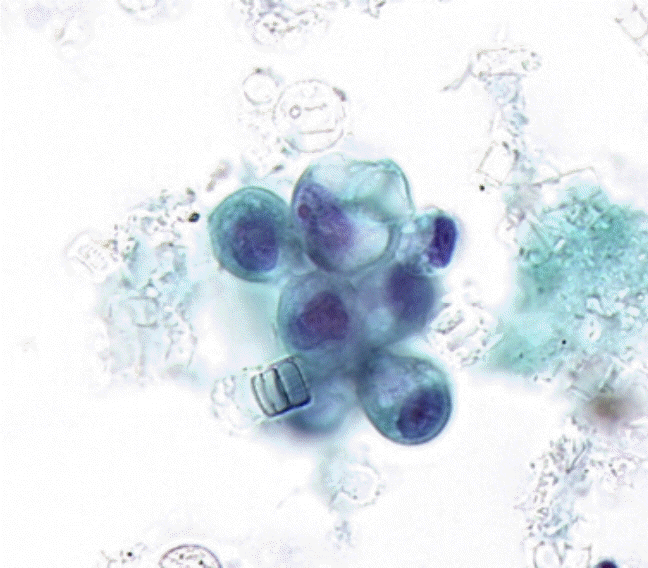A 75-year-old woman visited our emergency department with acute altered mental status preceded by a headache, nausea, and vomiting for 3 days. Except for a drowsy mental status, there were no focal neurological signs. Her initial vital signs were blood pressure 220/120 mm Hg, body temperature 36.1°C, heart rate 51 per minute, respiratory rate 20 per minute, and O2 saturation 95%. No abnormalities were noted on brain computed tomography. A cerebrospinal fluid (CSF) analysis revealed elevated opening pressure (210 mm Hg) and mononuclear pleocytosis (60 cells/mm³) with elevated proteins (183 mg/dL) and decreased glucose (30 mg/dL) with a low CSF-to-serum glucose ratio (
Table 1). The EEG showed an evolving pattern of rhythmic delta activity (>2.5 Hz) with response to intravenous benzodiazepine, a finding compatible with NCSE (
Fig. 1). Antiepileptic treatment for NCSE was started with valproic acid 2,000 mg as a loading dose and 1,000 mg twice daily for maintenance. Burst suppression was achieved on EEG using midazolam (0.2 mg/kg/hr) continuous infusion treatment. Brain magnetic resonance imaging showed diffuse meningeal enhancement (
Fig. 2). Through further evaluation, a lesion of suspected primary lung cancer was noted on chest computed tomography (
Fig. 3), but no masses were noted in the abdomen or pelvis. Bronchoscopy-guided biopsy failed because it was difficult to approach to the lesion’s site. Instead, bronchial washing cytology was done, but no malignant cells were detected. In a tumor marker screening test, elevated levels of carbohydrate antigen 19-9 (CA19-9), CA125, and CA 15-3 were detected (
Table 2). CSF cytopathology revealed metastatic adenocarcinoma, which was confirmed as being of lung origin (
Fig. 4). Autoimmune synaptic encephalitis antibodies (N-methyl-D-aspartate receptor [NMDAR], α-amino-3-hydroxy-5-methyl-4-isoxazolepropionic acid receptor [AMPA1/2], leucine-rich glioma inactivated 1 [LGI1], contactin-associated protein-like 2 [CASPR2], gamma-aminobutyric acid [GABA]-B) and paraneoplastic syndrome antibodies (anti-ANNA-1, antineuronal nuclear antibody-type 1 [anti-Hu], anti-PCA-1, Purkinje cell cytoplasmic anti-body type 1 [anti-Yo], ANNA-2, antineuronal nuclear antibody-type2 [anti-Ri], anti-paraneoplastic antigen MA2 [anti-PNMA2; Ma2/Ta], collapsing response-mediator protein-5 [CV2/CRMP5], antiamphiphysin, antirecoverin, antititin [MGT-30]) were negative; only SOX1 antibodies were detected (
Table 2). Despite the use of midazolam continuous infusion treatment and burst suppression being achieved on EEG, the patient was unresponsive to the first intrathecal chemotherapy (methotrexate 15 mg/day, cytarabine 30 mg/day, cortisol 50 mg/day) and expired suddenly 2 days later due to uncontrolled increased intracranial pressure.
 | Figure 1.Initial waking electroencephalography showed semirhythmic delta activity which showed responsiveness (arrow) after 2 mg intravenous lorazepam injection. 
|
 | Figure 2.(A-D) Brain magnetic resonance imaging shows meningeal enhancement around brainstem with focal nodular enhancement (arrows). 
|
 | Figure 3.(A-D) Chest computed tomography showing focal mass like conolidation in left lower lobe posterior basal segment medial aspect. 
|
 | Figure 4.Cytologic examination of the cerebrospinal fluid shows a few clusters of cells with enlarged eccentric nucleoli, prominent nucleoi and bubbly cytoplasm, suggesting metastatic adenocarcinoma (Papanicolaou stain, ×100). 
|
Table 1.
Cerebrospinal fluid analysis findings
|
Variable |
Value |
|
Intracranial pressure (mmH2O) |
210 |
|
Color |
Colorless |
|
pH |
7.5 |
|
SG |
1.01 |
|
Cell count (WBC) (mm3) |
60 |
|
Differential count (polymorphonuclear leukocyte) (%) |
- |
|
Differential count (lymphocyte) (%) |
43 |
|
Differential count (monocyte) (%) |
57 |
|
Glucose (CSF/serum) |
30/158 |
|
Protein (mg/dL) |
183 |

Table 2.
Paraneoplastic syndrome antibodies, autoimmune synaptic encephalitis antibodies, and serum tumor markers
|
Variable |
Result |
|
Paraneoplastic syndrome antibodies |
|
|
Hu |
(–) |
|
Yo |
(–) |
|
Ri |
(–) |
|
Ma2 |
(–) |
|
CV2/CRMP5 |
(–) |
|
Amphiphysin |
(–) |
|
Recoverin |
(–) |
|
SOX1 |
(+) |
|
Titin |
(–) |
|
Autoimmune synaptic encephalitis antibodies |
|
|
NMDAR |
(–) |
|
AMPA1 |
(–) |
|
AMPA2 |
(–) |
|
LGI1 |
(–) |
|
CASPR2 |
(–) |
|
GABA-B |
(–) |
|
Tumor marker |
|
|
AFP (ng/mL) |
1.02 |
|
CEA (ng/mL) |
14.2 |
|
CA19-9 (U/mL) |
<2.00 |
|
CA125 (U/mL) |
37.6 |
|
CA15-3 (U/mL) |
59.8 |

This study was approved by the Institutional Review Board of Dong-A University Hospital (IRB No: DAIHIRB-20-089). Informed consent was waived by the board.








 PDF
PDF Citation
Citation Print
Print



 XML Download
XML Download